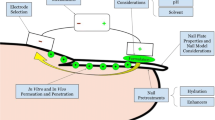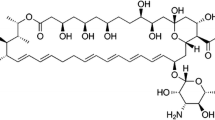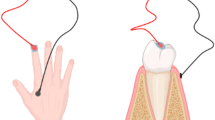Abstract
Purpose
Transport across the human nail under hydration can be modeled as hindered transport across aqueous pore pathways. As such, nail permselectivity to charged species can be manipulated by changing the ionic strength of the system in transungual delivery to treat nail diseases. The present study investigated the effects of ionic strength upon transungual passive and iontophoretic transport.
Methods
Transungual passive and anodal iontophoretic transport experiments of tetraethylammonium ion (TEA) were conducted under symmetric conditions in which the donor and receiver had the same ionic strength in vitro. Experiments under asymmetric conditions were performed to mimic the in vivo conditions. Prior to the transport studies, TEA uptake studies were performed to assess the partitioning of TEA into the nail.
Results
Permselectivity towards TEA was inversely related to ionic strength in both passive and iontophoretic transport. The permeability and transference number of TEA were higher at lower ionic strengths under the symmetric conditions due to increased partitioning of TEA into the nail. Transference numbers were smaller under the asymmetric conditions compared with their symmetric counterparts.
Conclusions
The results demonstrate significant ionic strength effects upon the partitioning and transport of a cationic permeant in transungual transport, which may be instrumental in the development of transungual delivery systems.






Similar content being viewed by others
References
R. P. R. Dawber, D. A. R. deBerker, and R. Baran. Science of the nail apparatus. In R. Baran, R. P. R. Dawber, D. A. R. deBerker, E. Haneke, and A. Tosti (eds.), Baran and Dawber’s Diseases of the Nails and their Management, Blackwell Science, Oxford, 2001, pp. 1–48.
R. P. R. Dawber, and R. Baran. Structure, embryology, comparative anatomy and physiology of the nail. In R. Baran, and R. P. R. Dawber (eds.), Baran and Dawber’s Diseases of the Nails and their Management, Blackwell Science, Boston, 1984, pp. 1–23.
M. Gniadecka, O. Faurskov Nielsen, D. H. Christensen, and H. C. Wulf. Structure of water, proteins, and lipids in intact human skin, hair, and nail. J. Invest. Dermatol. 110:393–398 (1998). doi:10.1046/j.1523-1747.1998.00146.x.
A. L. Lorincz, and R. B. Stoughton. Specific metabolic processes of skin. Physiol. Rev. 38:481–502 (1958).
J. L. Marty. Amorolfine nail lacquer: a novel formulation. JEADV. 4:S17–S21 (1995). doi:10.1016/0926-9959(94)00075-B.
B. Schulz, D. Chan, J. Backstrom, M. Rubhausen, K. P. Wittern, S. Wessel, R. Wepf, and S. Williams. Hydration dynamics of human fingernails: an ellipsometric study. Phys. Rev. E Stat. Nonlin. Soft Matter Phys. 65:061913–1–061913-7 (2002).
R. I. C. Spearman. The physiology of the nail. In A. Jarrett (ed.), The Physiology and Pathophysiology of the Skin, Vol. 5: The Sweat Glands, Skin, Permeation, Lymphatics, the Nails, Academic, New York, 1973, pp. 1812–1853.
Y. Kobayashi, T. Komatsu, M. Sumi, S. Numajiri, M. Miyamoto, D. Kobayashi, K. Sugibayashi, and Y. Morimoto. In vitro permeation of several drugs through the human nail plate: relationship between physicochemical properties and nail permeability of drugs. Eur. J. Pharm. Sci. 21:471–477 (2004). doi:10.1016/j.ejps.2003.11.008.
D. Mertin, and B. C. Lippold. In-vitro permeability of the human nail and of a keratin membrane from bovine hooves: prediction of the penetration rate of antimycotics through the nail plate and their efficacy. J. Pharm. Pharmacol. 49:866–872 (1997).
D. Mertin, and B. C. Lippold. In-vitro permeability of the human nail and of a keratin membrane from bovine hooves: penetration of chloramphenicol from lipophilic vehicles and a nail lacquer. J. Pharm. Pharmacol. 49:241–245 (1997).
D. Mertin, and B. C. Lippold. In-vitro permeability of the human nail and of a keratin membrane from bovine hooves: influence of the partition coefficient octanol/water and the water solubility of drugs on their permeability and maximum flux. J. Pharm. Pharmacol. 49:30–34 (1997).
K. A. Walters, G. L. Flynn, and J. R. Marvel. Physicochemical characterization of the human nail: I. Pressure sealed apparatus for measuring nail plate permeabilities. J. Invest. Dermatol. 76:76–79 (1981). doi:10.1111/1523-1747.ep12525318.
K. A. Walters, G. L. Flynn, and J. R. Marvel. Physicochemical characterization of the human nail: permeation pattern for water and the homologous alcohols and differences with respect to the stratum corneum. J. Pharm. Pharmacol. 35:28–33 (1983).
K. A. Walters, G. L. Flynn, and J. R. Marvel. Physicochemical characterization of the human nail: solvent effects on the permeation of homologous alcohols. J. Pharm. Pharmacol. 37:771–775 (1985).
K. A. Walters, G. L. Flynn, and J. R. Marvel. Penetration of the human nail plate: the effects of vehicle pH on the permeation of miconazole. J. Pharm. Pharmacol. 37:498–499 (1985).
A. Srebrnik, S. Levtov, R. Ben-Ami, and S. Brennert. Liver failure and transplantation after itraconazole treatment for toenail onychomycosis. JEADV. 19:205–207 (2005). doi:10.1111/j.1468-3083.2005.00943.x.
C. O. Wilson, J. H. Block, O. Gisvold, and J. M. Beale. Appendix, Wilson and Gisvold’s Textbook of Organic, Medicinal and Pharmaceutical Chemistry. Lippincott Williams & Wilkins, Philadelphia, 2004, pp. 948–956.
J. Hao, and S. K. Li. Transungual iontophoretic transport of polar neutral and positively charged model permeants: effects of electrophoresis and electroosmosis. J. Pharm. Sci. 97:893–905 (2008). doi:10.1002/jps.21025.
J. Hao, K. A. Smith, and S. K. Li. Chemical method to enhance transungual transport and iontophoresis efficiency. Int. J. Pharm. 357:61–69 (2008). doi:10.1016/j.ijpharm.2008.01.027.
R. H. Khengar, S. A. Jones, R. B. Turner, B. Forbes, and M. B. Brown. Nail swelling as a pre-formulation screen for the selection and optimisation of ungual penetration enhancers. Pharm. Res. 24:2207–2212 (2007). doi:10.1007/s11095-007-9368-3.
M. P. James, R. M. Graham, and J. English. Percutaneous iontophoresis of prednisolone—a pharmacokinetic study. Clin. Exp. Dermatol. 11:54–61 (1986). doi:10.1111/j.1365-2230.1986.tb00424.x.
S. N. Murthy, D. E. Wiskirchen, and C. P. Bowers. Iontophoretic drug delivery across human nail. J. Pharm. Sci. 96:305–311 (2007). doi:10.1002/jps.20757.
J. Hao, and S. K. Li. Mechanistic study of transungual electroosmosis transport across hydrated nail plates: effects of pH and ionic Strength. J. Pharm. Sci. 97:5186–5197 (2008). doi:10.1002/jps.21368.
S. N. Murthy, D. C. Waddell, H. N. Shivakumar, A. Balaji, and C. P. Bowers. Iontophoretic permselective property of human nail. J. Dermatol. Sci. 46:150–152 (2007). doi:10.1016/j.jdermsci.2006.12.010.
A. B. Nair, S. R. Vaka, S. M. Sammeta, H. D. Kim, P. M. Friden, B. Chakraborty, and S. N. Murthy. Trans-ungual iontophoretic delivery of terbinafine. J. Pharm. Sci. (2009) in press. doi:10.1002/jps.21555.
J. Hao, K. A. Smith, and S. K. Li. Iontophoretically enhanced ciclopirox delivery into and across human nail plate. J. Pharm. Sci. (2009) in press. doi:10.1002/jps.21664.
S. K. Li, A. H. Ghanem, K. D. Peck, and W. I. Higuchi. Iontophoretic transport across a synthetic membrane and human epidermal membrane: a study of the effects of permeant charge. J. Pharm. Sci. 86:680–689 (1997). doi:10.1021/js960479m.
D. S. Wishart, C. Knox, A. C. Guo, S. Shrivastava, M. Hassanali, P. Stothard, Z. Chang, and J. Woolsey. DrugBank: a comprehensive resource for in silico drug discovery and exploration. Nucleic Acids. Res. 34:D668–D672 (2006). doi:10.1093/nar/gkj067.
S. M. Sims, W. I. Higuchi, V. Srinivasan, and K. D. Peck. Ionic partition coefficients and electroosmotic flow in cylindrical pores: comparison of the predictions of the Poisson–Boltzmann equation with experiment. J. Colloid Interface Sci. 155:210–220 (1993). doi:10.1006/jcis.1993.1027.
P. C. Hiemenz, and R. Rajagopalan. The Electrical Double Layer and Double-Layer Interactions. In Principles of Colloid and Surface Chemistry. Marcel Dekker, New York, 1997, pp. 499–533.
R. Schmuhl, K. Keizer, A. van den Berg, J. E. ten Elshof, and D. H. A. Blank. Controlling the transport of cations through permselective mesoporous alumina layers by manipulation of electric field and ionic strength. J. Colloid Interface Sci. 273:331–338 (2004). doi:10.1016/j.jcis.2003.10.024.
T. Kuo, L. A. Sloan, J. V. Sweedler, and P. W. Bohn. Manipulating molecular transport through nanoporous membranes by control of electrokinetic flow: effect of surface charge density and Debye length. Langmuir. 17:6298–6303 (2001). doi:10.1021/la010429j.
W. M. Deen. Hindered transport of large molecules in liquid-filled pores. AlChE J. 33:1409–1425 (1987).
J. B. Phipps, and J. R. Gyory. Transdermal ion migration. Adv. Drug Deliv. Rev. 9:137–176 (1992). doi:10.1016/0169-409X(92)90022-I.
J. R. Vinograd, and J. W. McBain. Diffusion of electrolytes and of the ions in their mixtures. J. Am. Chem. Soc. 63:2008–2015 (1941). doi:10.1021/ja01852a063.
K. D. Peck, A. H. Ghanem, W. I. Higuchi, and V. Srinivasan. Improved stability of the human epidermal successive permeability experiments. Int. J. Pharm. 98:141–147 (1993). doi:10.1016/0378-5173(93)90050-P.
W. H. M. Craane-van Hinsberg, L. Bax, N. H. M. Flinterman, J. Verhoef, H. E. Junginger, and H. E. Bodde. Iontophoresis of a model peptide across human skin in vitro: effects of iontophoresis, protocol, pH, and ionic strength on peptide flux and skin impedance. Pharm. Res. 11:1296–1300 (1994). doi:10.1023/A:1018994428375.
Acknowledgments
This research was supported by NIH Grant GM063559 and in part by a grant from Boehringer Ingelheim Cares Foundation for the thesis work of Kelly A. Smith.
Author information
Authors and Affiliations
Corresponding author
Rights and permissions
About this article
Cite this article
Smith, K.A., Hao, J. & Li, S.K. Effects of Ionic Strength on Passive and Iontophoretic Transport of Cationic Permeant Across Human Nail. Pharm Res 26, 1446–1455 (2009). https://doi.org/10.1007/s11095-009-9854-x
Received:
Accepted:
Published:
Issue Date:
DOI: https://doi.org/10.1007/s11095-009-9854-x




